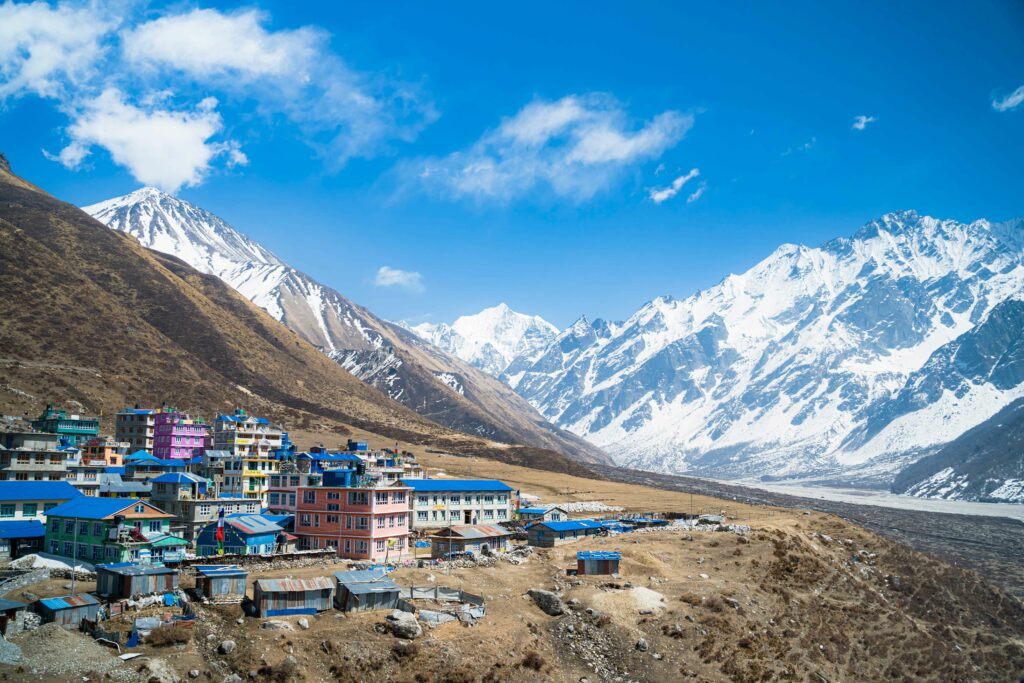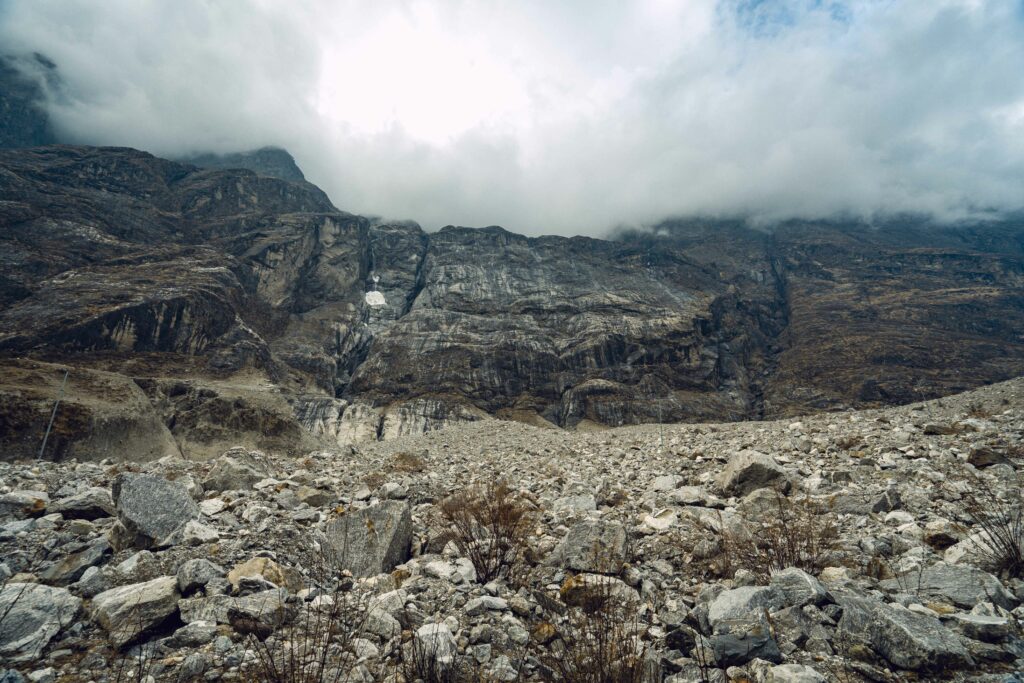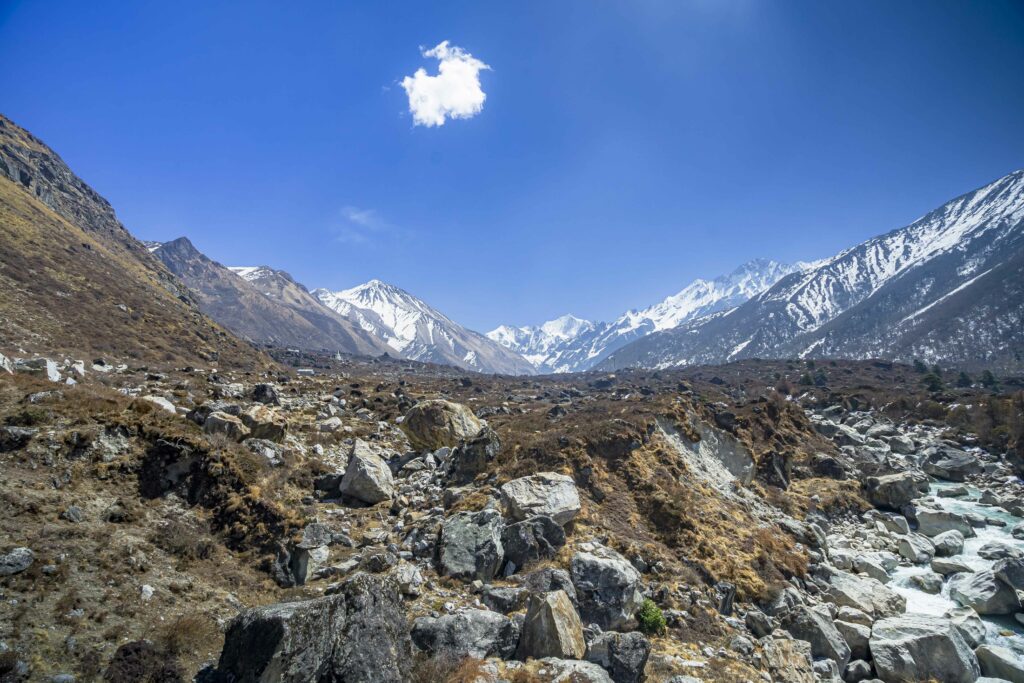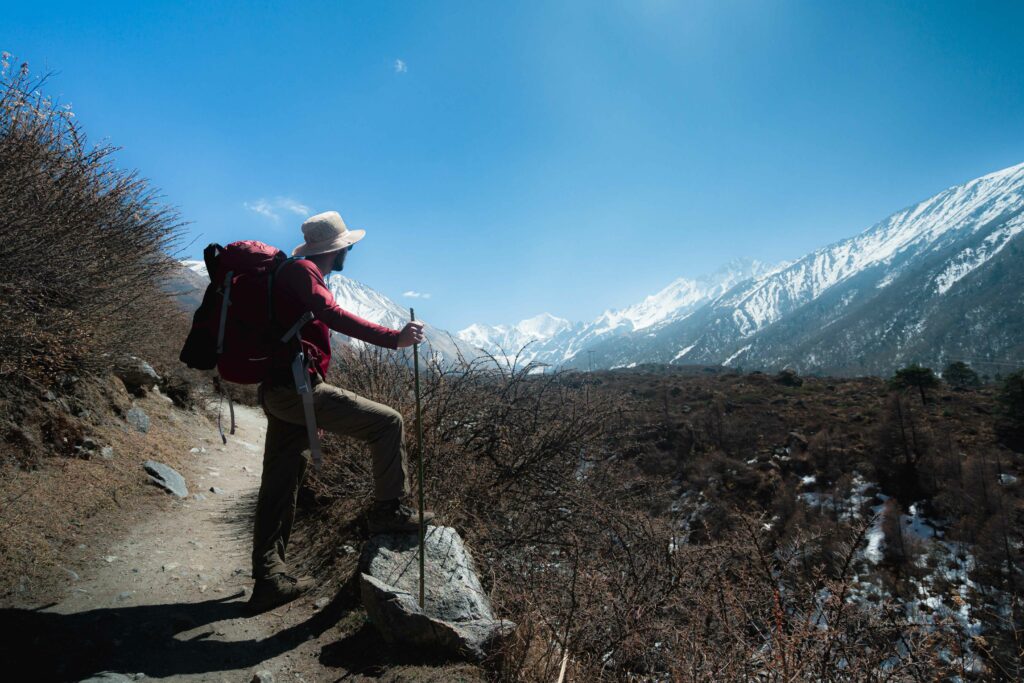
In the local language, Langtang means a place where the ox was found. Long ago people of Langtang imported an ox from Tibet to use it for religious purposes. But the ox escaped and was missing. Looking for the ox for a few days, they came to find the ox at a place in the Himalayas and named it Langtang. Langtang lies in Rasuwa District of Bagmati province in Nepal. Yearly a lot of domestic and international tourists visit this place for trekking. One can experience hilly culture and beauty and reach the lap of Himalayas through this trekking route.
Most of the time we travel on four-wheelers, this time we completed the journey on foot. While walking ups and downs, our bodies complained a lot but we were focused to reach Langtang so we walked ignoring our difficulties. The journey was therefore a journey of conflict between body and consciousness. It was a journey of war between fatigue and determination.
To reach Syaprubesi, the starting point of the Langtang Trek, we need to travel 6 hours from Kathmandu. There are two ways to get there from Kathmandu. One is through Prithvi Highway and the other is through Tokha which travels through Shivapuri National Park. For those who have their own vehicles the road from Tokha is a shorter alternative. As we weren’t well known to the Tokha’s way, we decided to travel through Prithivi Highway
To reach Rasuwa from Kathmandu, one has to cross the Nuwakot district. Nuwakot is about 81 kilometers from Kathmandu. We have to travel 3 hours to get there. On reaching Bidur, we can see two roads one that leads to Nuwakot and next to Rasuwa. After a short trip on the hilly roads from Bidur, we reached Nuwakot.
Nuwakot district holds great importance in the political history of Nepal. According to history, King Prithvi Narayan Shah conquered this place to make Kathmandu economically weak as it was the most important trade center for Kathmandu.
Another attraction of Nuwakot is the Nuwakot Palace. This palace was built in 1819 BS by Prithvi Narayan Shah by hiring the best artists from Lalitpur. At that time, Nuwakot Durbar was built nine stories. The palace was later reduced to seven stories as the upper two floors collapsed in the 1990 BS earthquake.

Even a few years ago, in the devastating earthquake of 2072 BS, this palace suffered heavy damage. Reconstruction work is still going on to give Nuwakot Durbar its old look. When we set foot in that sacred place rich in art, culture, and history, our minds were recalling the stories of Nepal’s unification. After being lost for a while in the land where the Gorkhali soldiers fought in the past, we went out to watch the sunset at the nearby viewpoint.
The color of the setting sun probably has the power to eliminate the fatigue of the day. We reached the viewpoint with tired bodies after a long day’s drive but returned with new energy for the trek. To make us feel even better we had not only the setting sun but also a few cups of warm milk tea and the company of our close friends.
We started our day with the view of Sunrise from Nuwakot. After wandering around the View Tower, we returned to the hotel. After having our breakfast we set out on our journey to Syaprubesi.
It takes about 3 hours to reach Syaprubesi from Nuwakot. To reach Syaprubesi one has to cross a place called Betravati.
After resting for a while at Betrawati, we again headed towards Dhunche, the district headquarters of Rasuwa. Moving on from Betrabati, we traveled on a blacktop road for a while. That blacktopped road reached Gumti Bazar. The Road from Gumti Bazar was a mixed one somewhere it was blacktopped and somewhere graveled. The road made breaking the huge rocks of the hills was scary to travel. Looking down from the road, one would skip a breath.
The day turned into evening as we reached Dhunche. There were still a few more km to reach Syaprubesi. The road to Syafru from Dhunche is downhill.
After breakfast, we started our Langtang trek through the streets of Syaprubesi. We knew that the road was long and we had to walk all day, but the excitement of the journey and the desire to see Langtang were so strong that we were not disturbed by the difficulties ahead.

From the first day of the trek, the river started walking along with us like a friend. After walking on the dirt road for a while, we crossed a crumbling suspension bridge and came to a place called Domen.
The main difference between a trek and other trips is that as one travels at a slow pace on foot, it gives us room to be close to nature. We see things we normally don’t see when we are on a trek.
Walking uphill increases breathing. When the horizontal path arrives, breathing gets easier. On a trek, it feels as if the breath is playing a game. What’s even more exciting is that the trekker gets to hear the sweet sound of birds, gets a chance to talk to the flowing river, and also gets to pause for a moment and think about life.
When we reached Bambu, our bodies were longing for rest. Fatigue was accompanied by hunger. If we were regular trekkers we wouldn’t have felt so much fatigue. After having our lunch in Bambu, we had to walk another 3 hours to reach Lama Hotel that day. So without further ado, we headed towards Lama Hotel.
Lunch added a little bit of strength to our bodies. Rest is always very important on a trek. For the purpose of having our lunch, we got a rest for a few moments which helped us move forward with more ease.
The River flowing on the side was still with us as we reached Rimche. Our bodies, terrified by the heat after walking for the whole day, were feeling cool just by seeing the cold water of the river. As we approached Rimche, we had to cross a difficult road with a landslide. Time and again, rocks kept falling from the landslide. Keeping that in mind we crossed the landslide with fear.

A black dog was following us from Bamboo. While traveling to an unknown place, he became our reliable friend.
After reaching Rimche and resting there for a while, the journey proceeded towards Lama Hotel again. Enjoying the beauty of the path, we reached Lama Hotel after about 15 minutes from Rimche.
We had decided to reach Langtang village from Lama Hotel on the second day, so we got up early and started preparing for the trek. Unlike Kathmandu, Lama Hotel had a deep peace in the morning. The chirping of the birds and the sound of the flowing river made the morning even more beautiful.
As we were leaving the lama hotel the mules were descending downwards. Our bodies were tired from the previous day’s trek. At first, we felt uncomfortable walking, but after walking for a while, our bodies gradually started feeling comfortable.
On a trek, we cannot know beforehand, how our destinations look and how much time it takes to reach there. We also can not speed up like a car to reach there fast. Walking slowly, getting tired, drinking water, listening to friends, and telling things to them, this is how a trekker reaches his /her destination.
Trekking makes people tired but does not allow them to stop. It says, walk slowly but keep walking. It encourages trekkers saying every step brings the destination closer. You can get tired here but you can’t escape, trekking whispers in the ear of a trekker. Before reaching Langtang we have to cross places like Riverside, Ghodatabela, Thangsap, and Gumba. We can fill our water bottles and take short rests at these destinations.
When we rested on the grass in the warmth of the sun, our sweat evaporated from our bodies, but after resuming the journey, we started sweating again. But we didn’t complain. We knew that the process of sweating and drying tells us that the destination is getting closer.
After reaching Ghodatabela, every pedestrian has to show the entrance ticket one has got from the Langtang National Park gate at Dhunche. From there it takes about an hour and a half to reach Thangsyap. As the mountains start to appear ahead, the fatigue disappears for a moment. The sun was about to set when we left Thangsap. It was still a long way to reach Langtang.
Trekking is truly an amazing journey. Get up in the morning, eat breakfast, walk again, eat lunch and walk again. There is only one thing to do and that is to walk. But what we see around us doesn’t give us an option to complain. Looking at the new people, the new geography, and the new culture, the day passes in a blink of an eye.
After a short walk from Thangsap, we came to a small village called Gumba. As we descended from the monastery, we were heartbroken by what we saw. There was a huge landslide lying on the ground. About 200 of Langtang’s population and an entire village were buried under the landslide. That buried village and its people are still sleeping under the same landslide to date. The landslide caused by the earthquake in 2072 BS ended the future of the place in a blink of an eye and what remains today is just the past. People sleeping under the landslide are now alive only in the memories of their relatives and friends. It seems that nature has also borne a sin by killing so many people, cultures, and history.

We had no option but to walk over the place where those people were buried. There was no other way to reach the new Langtang village. We were feeling sadness seeping inside us. As if the injury suffered by Langtang was transferred to our hearts. Life is unpredictable. No one knows when and where it will end.
An uneasiness was still alive in our minds till we traveled some distance after the landslide. The hotel we reached was built at the end of the place, so we got to see the village on our way to the hotel. While walking with the unpleasant experience of landslides in our minds, we saw the locals making liquor with smiling faces. That made us forget the misery and smile again. That day we also learned to hide our sorrow and smile like the locals in Langtang.
After walking for about seven to eight hours, we reached Langtang on the fourth day of our journey. Chime Renjin ( hotel owner ) prepared delicious noodles for us. We were so hungry that we emptied the place in no time.
The weather was cold. To avoid that cold, Jangmo didi ( Hotel Owner’s Mom ) set fire to the stove inside the room. The warmth of the fire gave some relief to our tired bodies.
After having the noodles prepared by our beloved brother Chime Renjin in the morning we started our journey to Kyanjin. That day we had to walk less than the day before. On the way from Langtang to Kanjin, we should cross Mundu and Sindum. Probably due to the trek of the past two days our body was not that afraid to walk.
It was Holi ( Festivals of colors ) and we were lost in the beautiful landscape of Langtang. On the way from Langtang to Kanjin, huge peaks started to be seen. On the first day of the journey, we were in Nuwakot where the society has been practicing Hinduism for many years, and after a few days’ walk, we arrived here in the world of Buddhism. Nepal is beautiful due to such diversity. Despite the differences in religion, society, and culture within a few miles, the unity of Nepalis is unbreakable. This is something we need to be proud of.

As the Buddhist land kyanjin was approaching, we started to see a few gumbas and Mane ( a Buddhist praying architect ) When we got there, one of the Gumba was being worshiped. The day was auspicious according to the Tibetan calendar, so locals gathered to change the flag and receive the lama’s blessing. There is a belief that if the flag is changed and blessings of the lama are taken, one will prosper in life and will have good health.
It is customary to eat and feed the prasad after performing puja. Being there at the right time we also got to eat prasad. We also learned that accepting the offerings primarily offered to Buddha would prolong one’s life and lead to success.
When we reached Kanjin after three days of continuous walking, we were surprised to see the landscape. Surrounded by mountains like Langtang Lirum, Dhambu, Therpa Che, Kim Chong, and Tsergo Ri, that place seemed truly supernatural. When you reach your destination on foot unlike on other journeys, you will feel that you have achieved something of great value. Instead of complaining about the pain, our bodies suffered. We were congratulating ourselves. Probably the beauty of Trekking lies in such beautiful moments.
After reaching Kanjin and eating our lunch, we set out to visit Kanjin village. During the visit, we came to know that Kanjin village has an 800-year-old history. The locals also said that a settlement of Kyanjin started when their forefathers started visiting this place for grazing their yaks. At present, due to the development of tourism, most of the people here are engaged in the tourism business.
It is believed that about 600 years ago, Guru Rinpoche dropped a letter from the sky on Kyanjin. The letter contained instructions from Guru Rinpoche to build four monasteries. It was a big challenge for the people here to build 4 monasteries at that time. As per the instructions of Guru Rinpoche, 4 monasteries could not be built but the locals built 2 monasteries. One in Kanjin and the other in Langtang. The Kanjin Gumba we see in Kanjin is one of the two. Therefore, this monastery has been established as a major center of religious importance in the Langtang region. Everyone who goes to Langtang needs to get there once.
In the morning the beautiful yellow rays of the sun painted the Langtang range. Kyanjin Village, which was hidden in the darkness of the previous night, smiled showing the white teeth of mountains. We also smiled, imitating Kyanjin. Not only us but anyone who gets to see the sunrise at Kyanjin feels like smiling.
The sixth day of the journey was going to be the most difficult. Looking at the Kanjin Ri from where we were standing, it looked like a huge rock that could not be climbed. We were about to set out on a journey of about 3800 meters to 4700 meters that day. The journey was not easy, the higher you climbed, the thinner the air became. Our footsteps started to complain about the height. However, it took 6 days from Kathmandu to reach there. We were about to reach our destination so giving up was not an option.

We were in a world of mountains and in our front was the giant Kanjin Ri. We had to cross many steep slopes to get there. The closer you got to the mountains, the more artistic they looked. Maybe that is why no one showed any signs of stopping even if the body gasped for breath. Resting our tired bodies once in a while, we kept moving towards Kanjin.
When we reached Kyanjin Ri, we were all exhausted. But as we saw the view around us, it made us speechless. Below us Kanjin Village and Kanjin Gumba were basking in the hot sun. Langtang Lirung was standing still in front of us. Upper Kanjin Ri was calling us asking us to visit her too.
The beauty of Nepal is truly amazing and equally captivating wherever you go.
After stopping for a while in the lower Kyanjin Ri, our bodies got the desired rest. The upper Kyanjin Ri was still to be conquered. Without further delay, we headed to upper Kanjin as it would be difficult for us to walk if the wind started blowing.
The human heart is amazing. Just like trying to reach heights in the journey of life, Our heart was constantly urging us to go to the upper Kyanjin Ri. Poor steps, they have to go wherever the heart tells them to. The steps were exhausted but they couldn’t deny the order of the heart.
We reached the upper Kanjin after a terrifying uphill journey. From the upper Kyanjin Ri, Langtang Lirum and Ser Gori were seen closer. It was getting difficult to breathe as the air was thinner. Amidst that difficulty, we were trying to find the energy to celebrate our success. The radiance identical to when we win something big was seen on our faces.

This six-day Langtang trek was a special trek for all of us. First of all, our lazy bodies that would spend days on a chair got a few days of exercise. Our eyes got to see a new landscape. Our hearts got to meet new people and get closer to them. Life learned a new lesson in every step we took. It brought the realization that by walking continuously we will definitely reach the destination. When we got acquainted with the present of Langtang, we also got to know its dark past. We also realized that ups and downs are two sides of the same coin.
Trekking is therefore not just a journey but a means of knowing oneself and the country. Walking gives you a new perspective on life and gives you memories to cherish for a lifetime. We also returned from Langtang with new perspectives and memories of life. If you need the same things, you can find them on any trekking routes in the country. So, go claim your perspectives and lifelong memories.
Watch our travel video on Langtang Trek here



Comments are closed.